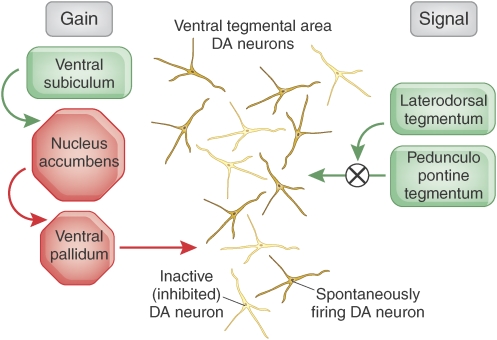Figure 3.
DA neurons in the VTA can exist in several activity states. In the basal, unstimulated state, DA neurons fire spontaneously at a slow, irregular rate. The VP provides a potent GABAergic input to DA neurons, causing a proportion of them to be tonically inhibited and non-firing. The VP in turn is controlled by afferents from the vSub and the NAc. When the vSub is activated, it provides a glutamatergic drive to the NAc, which in turn inhibits the VP and releases DA neurons from inhibition, allowing them to fire spontaneously. In contrast, the PPTg provides a potent direct glutamatergic input to DA neurons; when the PPTg is activated, it causes DA neurons to fire in bursts, which is believed to be the behaviorally salient pattern signaling a rewarding event. The impact of the PPTg, however, is gated by the LDT; only when the LDT is active can the PPTg initiate burst firing. In order for a DA neuron to burst fire, it must first be firing spontaneously. Given that the vSub controls the proportion of DA neurons firing spontaneously, it also sets the number of DA neurons that can be made to burst fire by the PPTg. As such, the PPTg drives the behaviorally salient burst firing, whereas the vSub provides the ‘gain' or amplification of the signal. The greater the vSub-driven gain, the larger the DA response produced by a stimulus that activates the PPTg.

